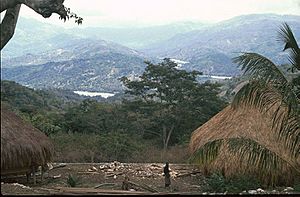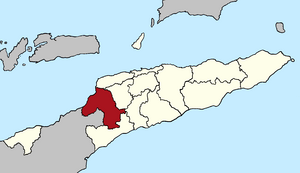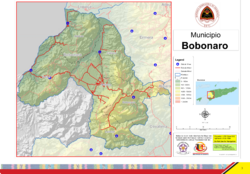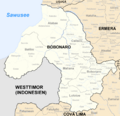Bobonaro Municipality facts for kids
Quick facts for kids
Bobonaro
|
||
|---|---|---|
|
||

Close to Maliana
|
||
|
||

|
||
|
OpenStreetMap
|
||
| Country | ||
| Capital | Maliana | |
| Administrative posts |
|
|
| Area | ||
| • Total | 1,378.1 km2 (532.1 sq mi) | |
| Area rank | 5th | |
| Population
(2015 census)
|
||
| • Total | 97,762 | |
| • Rank | 4th | |
| • Density | 70.9397/km2 (183.733/sq mi) | |
| • Density rank | 7th | |
| Households (2015 census) | ||
| • Total | 17,635 | |
| • Rank | 4th | |
| Time zone | UTC+09:00 (TLT) | |
| ISO 3166 code | TL-BO | |
| HDI (2017) | 0.606 medium · 8th |
|
Bobonaro is a special area in East Timor, a country in Southeast Asia. It's called a municipality and used to be known as a district. Bobonaro is located on the western side of East Timor.
About 92,045 people live here, based on the 2010 census. The municipality covers an area of 1,376 square kilometers.
Contents
What Does Bobonaro Mean?
The name Bobonaro comes from the local languages.
From Tetum Language
Some people say Bobonaro is a Portuguese way of saying the Tetum word Buburnaru. This word means 'tall eucalypt', referring to a type of tree.
From Bunak Language
In the local Bunak language, the words Ho and nalu are important. Ho means 'blood'. Nalu is a traditional woven basket, also called a 'bote' or 'taan'. This basket is carried on the back. When you put ho and nalu together, it can mean 'basket of blood' or 'basket of life'. Bobonaro sounds similar to this combination.
From Kemak Language
Another local language, Kemak, has words that sound like Bobonaro. Bobo means 'hide' and naru means 'long'. So, putting them together, it can mean a safe place where someone can hide for a long time.
Where is Bobonaro Located?
Bobonaro is in the western part of East Timor.
Borders and Neighbors
The Savu Sea is to the north of Bobonaro. The municipality shares its borders with other areas:
To the west, Bobonaro borders Indonesia, specifically the province of Nusa Tenggara Timur.
Capital City
The main city and capital of Bobonaro is Maliana. It is the fourth largest city in East Timor. In 2004, about 13,200 people lived there. Maliana is about 149 kilometers southwest of Dili, which is the capital city of East Timor.
Other Towns
Other important towns in Bobonaro include:
- Bobonaro City, also known as Aubá, with about 6,700 people.
- Lolotoi, with a population of about 3,800.
- Atabae, a village in the Atabae Administrative Post.
How Bobonaro is Organized
Bobonaro is divided into smaller areas called administrative posts. These used to be called sub-districts.
Administrative Posts List
There are six administrative posts in Bobonaro:
- Atabae
- Balibo
- Bobonaro
- Cailaco
- Lolotoe (sometimes spelled Lolotoi)
- Maliana
These administrative posts are further divided into 50 sucos, which are like small villages.
Roads and Borders
Bobonaro has important roads and border crossings.
Main Roads
A main road connects Dili to the Indonesian border at Batugade. This road goes through Bobonaro, following the coast for most of its way. It passes through the Atabae and Balibó administrative posts.
Border Crossings
There are two main places where people can cross the border between East Timor and Indonesia in Bobonaro:
- Batugade: This is the main border crossing. East Timor has an Immigration Post here. On the Indonesian side, the checkpoint is in Mota'ain.
- Tunibibi: This is a smaller border crossing near Maliana. The Indonesian checkpoint for this crossing is in Turiskain.
A Look at History
Bobonaro has a rich history and beautiful natural spots.
Natural Beauty and Challenges
This municipality was once a very popular place to visit because of its mountains and hot springs. However, it faced many challenges during the time East Timor was working to become an independent country.
Balibó's Story
Balibó, a town about 16 kilometers from the Indonesian border, was greatly affected during this period. It was estimated that 70% of the town was damaged. Balibó is also known for a sad event that happened on October 16, 1975. Five journalists from Australia, known as the Balibo Five, were killed there during a difficult time for East Timor.
Languages Spoken
Besides the official languages of Tetum and Portuguese, many people in Bobonaro speak other local languages. These include:
- Bekais
- Kemak
- Bunak
These languages are recognized as "national languages" in East Timor's constitution.
Images for kids
See also
 In Spanish: Distrito de Bobonaro para niños
In Spanish: Distrito de Bobonaro para niños




